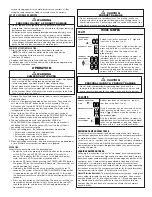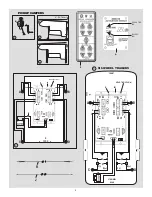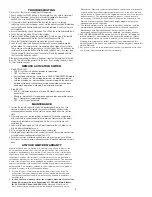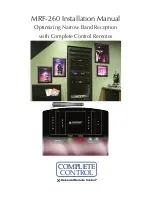
1
Refer to MPD 87903 and 71125 for complete installation, operation and
maintenance instructions for camper jacks and landing gear respectively.
For your saFety
read all instructions beFore operating
installer:
Provide these instructions to the consumer.
consumer:
Keep documents for future reference.
Our remote control is designed for use only with Electric Ball Screw Truck
Camper Jacks (EBSTCJ) equipped for remote control capability and Atwood
Landing Gears.
Atwood makes two types of EBSTCJ; one with remote
capability and one without;
they are not interchangeable
.
m
warning
Personal injury & Product damage
•
To deactivate the wireless system when you are finished hold down
the power-select on the remote until the LED turns off.
•
Only operate jack system when camper or trailer is unoccupied.
•
Store remote in a secure place, away from access by children.
•
Remove the battery from the handheld remote before storing to
prevent accidental jack activation or continuous remote transmission.
If the remote is continuously activated by a jammed or shorted button,
operation of other remote devices such as vehicle keyless entry systems
and/or garage door openers may be interfered with or prevented.
SPECIFICATIONS:
description
specifications
Channels:
1
Frequency:
315 MHz
Operating Temperature Range:
-20
o
C to 120
o
C
Power Source:
9-volt alkaline battery
Weight:
4.0 ounces
FCC Compliance Statement - Remote Control P/N 80430
This device complies with Part 15 of the FCC Rules. Operation is subject
to the following two conditions: (1) this device may not cause harmful
interference, and (2) this device must accept any interference received,
including interference that may cause undesired operation.
You do not need an FCC license to operate the wireless remote. However, any
changes or modifications to the device will void the user’s authority to operate
the equipment.
m
warning
exPlosion
•
To avoid possible interference with blasting operations, do not use
your remote near
electrical
blasting
caps
or in a
blasting
area
or in areas
posted:
t
urn
off
two
-
way
radio
. Obey all signs and instructions.
•
Do not use the remote near explosive atmospheres.
Explosive atmospheres are often, but not always, clearly marked. They
include fueling areas, fuel or chemical transfer or storage facilities:
areas where the air contains chemicals or particles, such as grain,
dust, or metal powders, and any other area where you would normally
literature
number
MPD 87974
WIRELESS
REmotE ContRoL
ENGLISH
•Installation •Operation •Maintenance
Effective 6/30/09
saFety alert symbols
Safety Symbols alerting you to potential personal safety hazards.
Obey all safety messages following these symbols.
m
warning
m
caution
avoid possible
avoid possible
injury or death
injury and/or property damage
be advised to turn off your vehicle engine.
InstallatIOn
m
caution
Product damage
•
Disconnect power to the power relay module prior to HiPot testing
of the camper or the microprocessor will be damaged.
note
:
fig
4 is overhead view of a pickup camper with power relay
module shown flat for clarity.
fig
5 is overhead view of 5th wheel trailer.
1. Install the power relay module in a clean, dry interior area protected
from moisture. Use the four (4) 1/4˝ diameter holes for mounting the
module relay (K). Position the base on the mounting surface and
secure it using appropriate hardware for the wall material. Orient
antennae straight away from base. Permanently secure antenna to
mounting surface with appropriate hardware. Mount the base RF
receiver unit (K) in the selected target location. Take care to ensure
that the antenna on the board is not located next to other electrical
wiring which could interfere with operation. Take care to ensure that
the target location has good RF reception (avoid “faraday cage”
scenarios, i.e. metal box).
m
caution
Product damage
•
Failure to orient antennae properly will result in intermittent
operation of the wireless remote system.
note
:
Correct polarity must be observed as noted on the circuit board
next to 5 & 4-H. The unit will not function if the input power is installed
in reverse polarity. See
fig
5 & 4.
A - Driver Front Jack or Leg
H - Input Power Terminal Block
B - Passenger Front Jack or Leg
I - Output Jack
C - Driver Rear Jack or Leveleg
J - Flat Cable
D - Passenger Rear Jack or Leveleg K - Relay Module (RF receiver)
E -
s
40 AMP Circuit Breaker
L - Antenna
s
For all camper jacks
M - Male Connector
or 60 AMP resetable
N - Female Connector
circuit breaker for
O - 30 AMP Fuses
8AWG battery wire.
P - Remote
F - Red (-) Motor Gear Box Lead
Q - Activation Switch
G - Yellow (+) Motor Gear Box Lead R - Audio Cable
S - Flat Cable Outlet
2.
supply
power
to
unit
:
The unit operates from a +12 VDC battery and must
be supplied through a 40 AMP circuit breaker (
fig
4E & 5-E). Route the
#8 AWG, +12 VDC from the circuit breaker and the ground wiring, to the
terminal block (
fig
4H & 5-H).Terminate the wires in the labeled positions.
3. Route the two #10 AWG wires from each jack to the terminal block 4-I
& 5-I. Refer to the labels next to each terminal position for driver front,
passenger front, driver rear, and passenger rear jacks. Connect the
wires for each jack.
4. Install the Activation Switch near the floor just inside the door of the
pickup camper or in an outside compartment of the fifth wheel. Plug the
flat cable (
fig
J) into the left side of the power relay module (
fig
4 & 5-S)
and route to the location of the activation switch (
fig
4 & 5-Q). Plug other
end of the cable into the back side of the activation switch. Connect the
optional accessory harnesses (controlling up to two additional motor
outputs) to their associated connector on the base receiver. Any use of
the accessory ports needs to be approved in advance by the manufacture
of the accessory. Connect the power harness to the base receiver. Take








